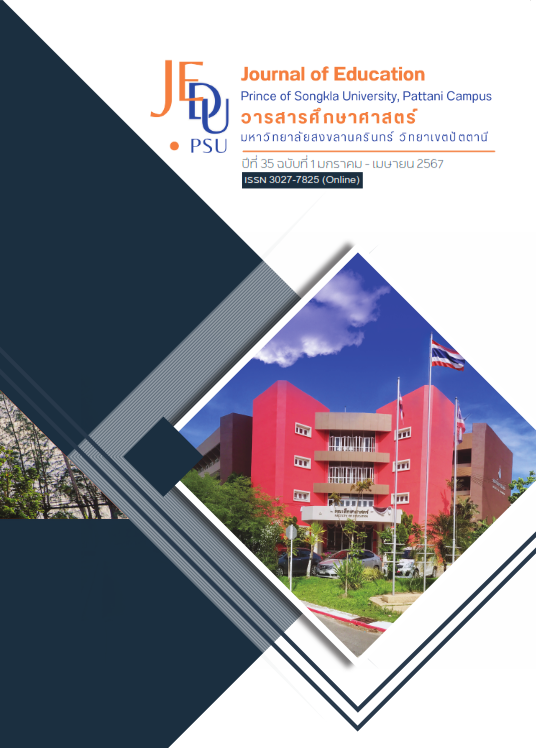ปัจจัยที่ส่งผลต่อผลิตภาพในการทำวิจัยของอาจารย์ในสายสังคมศาสตร์: กรณีศึกษา มหาวิทยาลัยสงขลานครินทร์ วิทยาเขตหาดใหญ่
Main Article Content
บทคัดย่อ
งานวิจัยนี้มีวัตถุประสงค์เพื่อศึกษาปัจจัยที่ส่งผลต่อผลิตภาพการทำวิจัยของอาจารย์ในสายสังคมศาสตร์ของมหาวิทยาลัยสงขลานครินทร์ วิทยาเขตหาดใหญ่ประกอบด้วย1) ปัจจัยแรงจูงใจจากภายใน 2) ปัจจัยทัศนคติเชิงบวกเกี่ยวกับการทำวิจัย 3)ปัจจัยความเชื่อเกี่ยวกับกลุ่มอ้างอิงในการทำวิจัย 4) ปัจจัยการรับรู้ความสามารถในการทำวิจัย และ 5) ปัจจัยการรับรู้การสนับสนุนจากองค์กร รวมไปถึงปัจจัยส่วนบุคคลอื่น ๆ โดยทำการวัดผลิตภาพการทำวิจัยของอาจารย์ทั้งจากมุมมองและการรับรู้ของอาจารย์ และจำนวนผลงานวิจัยที่มีการตีพิมพ์เผยแพร่ในปีที่ผ่านมา ผู้วิจัยใช้แบบสอบถามเป็นเครื่องมือในการเก็บข้อมูล ซึ่งมีจำนวน 29 ข้อ โดยเก็บข้อมูลจากอาจารย์กลุ่มสายสังคมศาสตร์มหาวิทยาลัยสงขลานครินทร์ วิทยาเขตหาดใหญ่ ประกอบด้วย คณะวิทยาการจัดการ คณะศิลปศาสตร์ คณะเศรษฐศาสตร์ คณะนิติศาสตร์ และสถาบันสันติศึกษา ได้รับแบบสอบถามกลับคืนมาทั้งสิ้น 111 ชุด (คิดเป็นร้อยละ 59.68) จากนั้นดำเนินการวิเคราะห์ข้อมูลด้วยการวิเคราะห์ถดถอยพหุคูณ (Regression) ผลการวิจัยพบว่า ปัจจัยที่ส่งผลต่อผลิตภาพการทำวิจัยของอาจารย์อย่างมีนัยสำคัญทางสถิติ ได้แก่ การมีตำแหน่งวิชาการ การเป็นอาจารย์ที่ปรึกษาวิทยานิพนธ์/สารนิพนธ์ และการรับรู้ความสามารถในการทำวิจัย โดยพบว่า 1) อาจารย์ที่มีตำแหน่งรองศาสตราจารย์จะมีผลงานวิจัยมากกว่าอาจารย์ที่ไม่มีตำแหน่งวิชาการ 2) การเป็นอาจารย์ที่ปรึกษาวิทยานิพนธ์/สารนิพนธ์ทำให้มีงานวิจัยมากกว่าอาจารย์ที่ไม่เป็นที่ปรึกษาฯ และ 3) การรับรู้ความสามารถในการทำวิจัย ส่งผลให้อาจารย์มีผลิตภาพการทำวิจัยสูงขึ้น ส่วนปัจจัยอื่น ๆ ไม่ส่งผล
Article Details

อนุญาตภายใต้เงื่อนไข Creative Commons Attribution-NonCommercial 4.0 International License.
เอกสารอ้างอิง
Abramo, G., & D’Angelo, C. A. (2014). How do you define and measure research productivity? Scientometrics, 101(2), 1129-1144.
Ajzen, I. (1991). The theory of planned behavior. Organizational Behavior and Human Decision Processes, 50(2), 179-211.
Albach, P & Lewis, L. (1995). ‘College teachers-attitudes’. Change, 27(6), p. 50. Armeli, S., Eisenberger, R., Fasolo, P., & Lynch, P. (1998). Perceived organizational support and police performance: the moderating influence of socioemotional needs. Journal of Applied
Psychology, 83(2), 288.
Brand, M. (2000), Changing faculty roles in research universities: using pathways strategy. Change, 32(6), 42-45.
Cargile, B & Bublitz, B. (1986). Factors contributing to published research by accounting faculties. The Accounting Review, 61(1), 158-178.
Cui, R., Ding, H., & Zhu, F. (2022). Gender inequality in research productivity during the COVID-19 pandemic. Manufacturing Service Operations Management, 24(2), 707-726.
Deci, E. L., & Ryan, R. M. (1985). Self-Determination. Wiley Online Library.
Del Gatto, M., Di Liberto, A., & Petraglia, C. (2011). Measuring productivity. Journal of Economic Surveys, 25(5), 952-1008.
Dose, E., Desrumaux, P., & Bernaud, J. (2019). Effects of perceived organizational support on objective and subjective career success via need satisfaction: A study among french psychologists. Journal of Employment Counseling, 56(4), 144-163.
Dundar, H., & Lewis, D. R. (1998). Determinants of research productivity in higher education. Research in Higher Education, 39(6), 607-631.
Eisenberger, R., Armeli, S., Rexwinkel, B., Lynch, P. D., & Rhoades, L. (2001). Reciprocation of perceived organizational support. Journal of Applied Psychology, 86(1), 42.
Eisenberger, R., Huntington, R., Hutchison, S., & Sowa, D. (1986). Perceived organizational support. Journal of Applied Psychology, 71(3), 500-507.
Fishbein, M., & Ajzen, I. (1975). Belief, attitude, intention and behavior: An introduction to theory and research. Reading, MA: Addison-Wesley.
Gibbs, P & Locke, B 1989, ‘Tenure and promotion in accredited graduate social work program’, Journal of Social Work Education, 25(2), 126-133.
Grant, A. M. (2008). Does intrinsic motivation fuel the prosocial fire? Motivational synergy in predicting persistence, performance, and productivity. Journal of Applied Psychology, 93(1), 48-58.
Hair, J. F., Black, W. C., Babin, B. J., & Anderson, R. E. (2018). Multivariate Data Analysis. (8th ed.). United Kingdom: Cengage Learning.
Hilmer, C. E., & Hilmer, M. J. (2007). On the relationship between the student-advisor match and early career research productivity for agricultural and resource economics Ph. Ds. American Journal of Agricultural Economics, 89(1), 162-175.
Kurtessis, J. N., Eisenberger, R., Ford, M. T., Buffardi, L. C., Stewart, K. A., & Adis, C. S. (2015). Perceived organizational support: A meta-analytic evaluation of organizational support theory. Journal of Management, 43(6), 1854-1884.
Lertputtarak, S. (2008). An investigation of factors related to research productivity in a public university in Thailand: A case study. [Doctoral dissertation, Victoria University].
Memon, M. A., Ting, H., Cheah, J. H., Thurasamy, R., Chuah, F., & Cham, T. H. (2020). Sample size for survey research: review and recommendations. Journal of Applied Structural Equation Modeling, 4(2), 1-20.
Muschallik, J., & Pull, K. (2016). Mentoring in higher education: Does it enhance mentees’ research productivity? Education Economics, 24(2), 210-223.
Nunnally JC. (1978). Psychometric methods, New York: McGraw-Hill.
Potipiroon, W., & Ford, M. T. (2017). Does public service motivation always lead to organizational,commitment? Examining the moderating roles of intrinsic motivation and ethical leadership. Public Personnel Management, 46(3), 211-238.
Ramsden, P. (1994). Describing and explaining research productivity. Higher education, 28(2), 207-226.
Ramesh Babu, A., & amp; Singh, Y. P. (1998). Determinants of research productivity. Scientometrics, 43, 309-329.
Ryan, R. M., & Deci, E. L. (2000). Self-determination theory and the facilitation of intrinsic motivation, social development, and well-being. American Psychologist, 55(1), 68-78.
Sabharwal, M. (2013). Comparing research productivity across disciplines and career stages. Journal of Comparative Policy Analysis: Research and Practice, 15(2), 141-163.
Shen, W., & Jiang, J. (2021). Institutional prestige, academic supervision and research productivity of international PhD students: Evidence from Chinese returnees. Journal of Sociology, 59(2), 552-579. doi.org/10.1177/14407833211055225
Stack, S. (2004). Gender, children and research productivity. Research in Higher Education, 45(8), 891-920.
Taylor, J. (2006). Managing the unmanageable: The management of research in research-intensive universities. Higher Education Management and Policy, 18(2), 1-25.
Tabachnick, B. G., & Fidell, L. S. (1989). Using multivariate statistics. (2nd ed.). Cambridge MA: Harper & Row.
Ul Haq, I., Ur Rehman, S., Al-Kadri, H. M., & Farooq, R. K. (2020). Research productivity in the health sciences in Saudi Arabia: 2008-2017. Annals of Saudi medicine, 40(2), 147-154.
Vuong, Q.-H., Napier, N. K., Ho, T. M., Nguyen, V. H., Vuong, T.-T., Pham, H. H., & Nguyen, H. K. T. (2019). Effects of work environment and collaboration on research productivity in Vietnamese social sciences: Evidence from 2008 to 2017 scopus data. Studies in Higher Education, 44(12), 2132-2147.
Wei, T., Sadikova, A. N., Barnard-Brak, L., Wang, E. W., & Sodikov, D. (2015). Exploring graduate students’ attitudes towards team research and their scholarly productivity: A survey guided by the theory of planned behavior. International Journal of Doctoral Studies, 10, 1.
Wichian, S. N., Wongwanich, S., & Bowarnkitiwong, S. (2009). Factors affecting research productivity of faculty members in government universities: Lisrel and neural network analyses. Kasetsart Journal of Social Sciences, 30(1), 67-78.
Williamson, I. O., & Cable, D. M. (2003). Predicting early career research productivity: The case of management faculty. Journal of Organizational Behavior, 24(1), 25-44.
Wooldridge, J. M. (2015). Introductory econometrics: A modern approach: Cengage learning.


